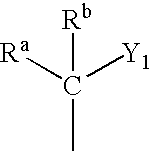Process for producing optically active halohydrin compound
a technology of halohydrin and compound, which is applied in the preparation of oxygen-containing compounds, organic chemistry, carbamic acid derivatives, etc., can solve the problems of inability to meet industrial production requirements, inability to achieve reaction progress, and low yield
- Summary
- Abstract
- Description
- Claims
- Application Information
AI Technical Summary
Benefits of technology
Problems solved by technology
Method used
Image
Examples
example 1
[0060]A solution of di-μ-chlorodichlorobis(pentamethylcyclopentadienyl)dirhodium (III) (155 mg, 0.025 mmol) and (1R,2R)-N-(p-toluenesulfonyl)-1,2-diphenylethylenediamine (36.6 mg, 0.1 mmol) in isopropyl alcohol (25.0 ml) was heated at 80° C. for 20 minutes while stirring. After cooling the solution to room temperature, a 0.1 M potassium tert-butoxide isopropyl alcohol solution (2.5 ml, 0.25 mmol) and an isopropyl alcohol solution (22.5 ml) of 2-chloroacetophenone (773.0 mg, 5.0 mmol) as a reaction substrate were added thereto, followed by stirring at room temperature for 14 hours. After completion of the reaction, the solvent was removed by evaporation, and the residue was purified by silica gel column chromatography to give a desired compound, (+)-2-chloro-1-phenylethanol (732.9 mg; yield: 93.6%; optical purity: 97.5% ee).
example 2
[0061]A solution of (+)-2-chloro-1-phenylethanol (156.6 mg, 1.0 mmol, 97.5% ee) in dichloromethane (2.0 ml) and a 2.0 M aqueous solution of sodium hydroxide (1.0 ml, 2.0 mmol) were mixed and stirred at room temperature for 4 hours. To the solution was added dichloromethane (2.0 ml), and the dichloromethane layer was washed with a saturated sodium chloride aqueous solution and dried over anhydrous sodium sulfate. The solvent was removed by evaporation. The residue was purified by silica gel column chromatography to give a desired compound, (+)-styrene oxide (115.2 mg; yield: 95.9%; optical purity: 97.5% ee).
example 3
[0062]A solution of di-μ-chlorodichlorobis(pentamethylcyclopentadienyl)dirhodium (III) (3.1 mg, 0.005 mmol) and (1R,2R)-N-(p-toluenesulfonyl)-1,2-diphenylethylenediamine (7.3 mg, 0.02 mmol) in isopropyl alcohol (5.0 ml) was heated at 80° C. for 20 minutes while stirring. After cooling the solution to room temperature, a 0.1 M potassium tert-butoxide isopropyl alcohol solution (0.5 ml, 0.05 mmol) and an isopropyl alcohol solution (4.5 ml) of 2-chloro-3′-methylacetophenone (168.6 mg, 1.0 mmol) as a reaction substrate were added thereto, followed by stirring at room temperature for 14 hours. After completion of the reaction, the solvent was removed by evaporation, and the residue was purified by silica gel column chromatography to give a desired compound, (+)-2-chloro-1-(3′-methylphenyl)ethanol (158.6 mg; yield: 93.0%; optical purity: 95.6% ee).
PUM
| Property | Measurement | Unit |
|---|---|---|
| temperature | aaaaa | aaaaa |
| pressure | aaaaa | aaaaa |
| pressure | aaaaa | aaaaa |
Abstract
Description
Claims
Application Information
 Login to View More
Login to View More - R&D
- Intellectual Property
- Life Sciences
- Materials
- Tech Scout
- Unparalleled Data Quality
- Higher Quality Content
- 60% Fewer Hallucinations
Browse by: Latest US Patents, China's latest patents, Technical Efficacy Thesaurus, Application Domain, Technology Topic, Popular Technical Reports.
© 2025 PatSnap. All rights reserved.Legal|Privacy policy|Modern Slavery Act Transparency Statement|Sitemap|About US| Contact US: help@patsnap.com



